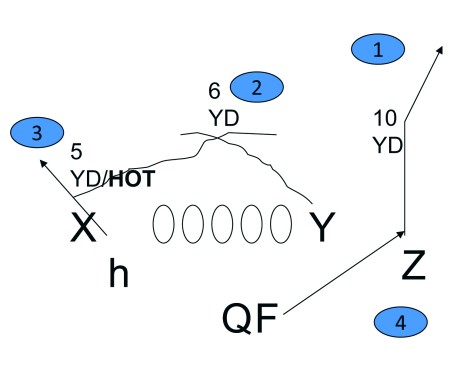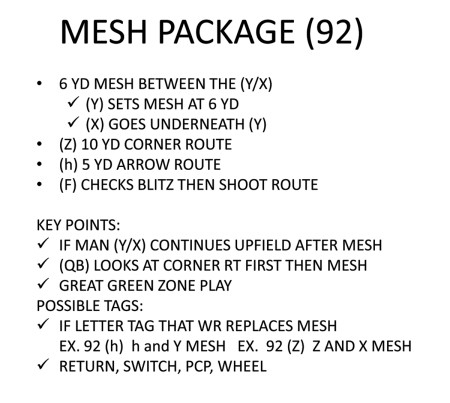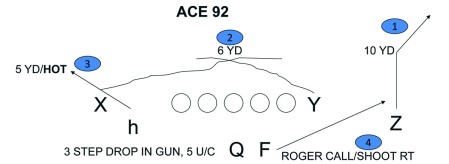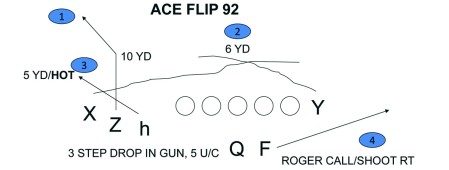Article CategoriesAFM Magazine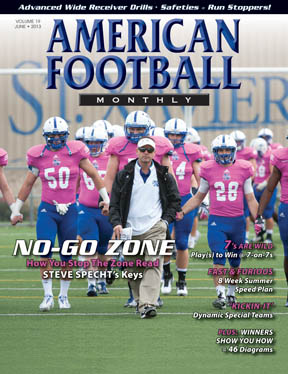
|
Wide Open – Coaches share strategies for winning in summer 7-on-7 competitions.by: David Purdum© More from this issue The explosion in popularity of off-season 7-on-7 passing competitions has helped coaches put a better product on the field in the fall, mainly through player development. But don’t discount the value of putting your playmakers in competitive, late-game situations. “Ideally, I want each of our games to be 21-14 on the final possession, with us trying to score or prevent the tying touchdown,” said Bryan Gray, head coach at East Hall High School (GA) and a big believer in the benefits of 7-on-7. After nearly a decade coaching his teams in 7-on-7 leagues, Gray raves about the conditioning, the improved communication and the overall skill development, especially with quarterbacks, that come from the off-season passing competitions. Gray keeps his 7-on-7 scheme as close as possible to his normal system, going so far as making his quarterback use play-action even though there are no running plays. He charts every throw, tries to get his quarterback to work on his mid-range game, even if it means calling the same play 10 straight times. “To us, it’s about winning in the fall not in the summer,” said Gray. “Without a doubt, we play a higher level of football in the fall because of 7 on 7.” One staple of Gray’s 7-on-7 offense is 92 mesh. His quarterback identifies the number of safeties and the receivers follow specific rules based on the defensive coverage. Depending on what the defense shows, the offense can run ‘Ace 92’ or ‘Ace Flip 92’- alternatives off of the 92 mesh package (Diagrams 1-3).
Diagram 1: QB Reads 92 Mesh
Diagram 2: ACE 92
Diagram 3: Ace Flip 92
Winning a tournament, of course, rarely hurts, either. Last summer, Hoover High School (Al) proved that winning a big 7-on-7 tournament can be a springboard to success in the fall. They won the National Select 7-on-7 Championship and went on to win the state championship in Alabama’s largest classification. “Our 7-on-7 competition last summer definitely helped prepare us for the fall season and we were more prepared and better conditioned,” said Head Coach Josh Niblett. Hoover completed an undefeated season in 2012. One of the most prestigious of the 7-on-7 tournaments is the NFL High School Player Development National 7-on-7 Tournament. Won last July by the team representing the Miami Dolphins, it was the fourth consecutive time a team representing the Dolphins won the championship. The HSPD 7-on-7 competition gets underway with regional tournaments which are hosted by NFL teams in all 32 league cities. There, 7-on-7 teams of 12 players and two coaches compete for the opportunity to represent their NFL team at the National Tournament, which this year will be hosted by the Cleveland Browns for the second time in three years. In last July’s event, players competed over a four day period which included character development sessions. The head coach of the winning team, Tim Harris, thoroughly enjoyed the entire program. “The NFL’s HSPD program really benefitted our kids both on and off the field,” said Harris. “The 7-On-7 competition brought us together as a team. We focused on each play – every four seconds – to build reps and become a more competitive team.” 7-on-7 not only benefits the players, but it also can be a great teaching tool for coaches, like Vince Ahearn and Dan Cunningham, two longtime instate rivals in Maryland. For years, they have teamed up to coach 7-on-7 squads and last year, they led an all-star group that represented the Baltimore Ravens in the HSPD National 7-on-7 tournament presented by the National Guard. Ahearn, who just took over at Williamsport High School, focuses on the defense while Cunningham, head coach of North Hagerstown High School, runs the offense. Both say they’ve learned from each other and are better football coaches in the fall because of it. They’ve also picked up a few 7-on-7 tricks along the way. Practice time is limited to a few pre-tournament meetings, during which players submit paperwork and meet their teammates. Learning the system comes during the tournament, leading to a hectic first day for the coaches. “We use the whole first day for installation,” explained Ahearn. “Defensively, I am extremely busy through the first day and the next morning. Every single play, I’m coaching up angles, drops and reads and getting guys to understand concepts.” Ahearn’s Automatic Key Coverage for 7-on-7 When two receivers are in the same proximity, e.g. twins, Ahearn employs over-the-top coverage with both the corner and safety reading the # 2 receiver’s release. If the # 2 goes vertical, the safety picks him up. If the receiver takes an outside release, the corner jumps the route. If it’s a slant, the underneath linebackers normally pick him up. Versus trips or any formation with a tight end, Ahearn uses robber coverage. “We don’t change defenses or hardly at all,” said Ahearn. “There are some teams that go in and change up their defenses, spinning their coverages and everything else. But sometimes, you can baffle your own kids more than you’re baffling the other side.” In the pre-snap alignment, the linebackers and corners are aligned five-yards off the line of scrimmage, with the safeties 10 to 12 yards off. Corners are in outside leverage with safeties “top and two.” Outside linebackers leverage toward the outside to help bracket the receivers. Linebackers either drop into the flat and come underneath routes or drop back into the seam to protect against the hook or curl. The middle linebacker matches the path of the single back, opening to the direction of the back and giving an additional coverage player. “Defensively, I’m more concerned about dividing the field between my single receiver, the tackles and the combination patterns on the other side,” said Ahearn. “There are three zones, and we’re indentifying each and playing based on that, not based on an entire coverage. “If I get trips, what is my answer to the single receiver?” Ahearn added. “If we’re not worried about him, I’m going to shift my linebackers inside and move everything over. I can maybe leave that guy man-to-man back there or bring my safety over. Now, if their guy is better than my guy, and they want to attack single coverage, we need to rotate our defense, move our linebackers to the single receiver and our coverage away. You’re either moving your coverage to strength and moving your linebackers away or you’re linebackers to strength and your coverage away.” Cunningham sees a lot of cover-2 defenses and prefers a dig concept against the two-high safety look. “The split end is going to run a 12- to 15 yard dig; then, we’re going to seam the # 2 receiver, and # 3 will seam him or bend him on the backside,” Cunningham said. “If the safeties split, then he’s going in between the safeties. If the safeties sit there, he’s going to bend back. And we always run some kind of curl on the backside with the # 4 receiver, and flare our back out away from a pre-snap read.” The quarterback reads the high-low safety. If he jumps the dig route, they’re instructed to go over the top with the seam route. “The dig is our big one,” said Cunningham. “A lot of teams will play a cover-2, but you’ll see teams spin down and do some spin coverages. Everybody’s different, and it’s pretty neat to see.” In the early years of Cunningham’s experience with 7-on-7, he brought two quarterbacks. But he quickly learned that splitting reps didn’t allow the quarterbacks to find their rhythm. In addition to the dig route, Cunningham likes to feature a snag route with his inside WR. “We’ll take the # 1 receiver and give him a read-option of a post or a go,” said Cunningham. “He’s reading the safety. If we get a one-high look, he’s going to attack that one-high safety. If we’re looking at two-high, then he’s going to run the vertical and try to get the safety on that side of the field. “The # 2 receiver runs what we call our snag rout,” he continued. “# 2 is attacking the inside linebacker, like a 30-technique or 40-technique. He’s going to plant inside, like he’s boxing out, and out of the side of his eye, he’s going to see the running back clear in the back. The running back is taking a 45 degree angle and getting into the flat. If the linebacker gets over the top and tries to jump the running back, then we have our inside guy sitting there for a 4-yard gain.” Cunningham believes the quarterback should read the corner first, then the linebacker. “If the corner is bailing, we’ll hit the running back for 20 yards, because we’ve cleared everyone out over there,” said Cunningham. “We’ll run it a couple of times and the corner will sit and that’s when we’ll attack over the top.” Cunningham said his teams began to have more success when they made some personnel adjustments, which produced more yards after the catch. “I like the kids on the outside that have speed and are good route-runners,” said Cunningham. “These are high school kids – when all else fails, the quarterback wants to throw deep. So if you have someone who can’t run a route, then the quarterback’s going to chuck it up and we’re going to get picked. I like to use our best route runners on the outside, because we can isolate a lot of those kids on the weak side.” In the beginning, Cunningham said he tried to run too many plays and was too concerned about the clock and pace of the game. He found that if he slowed things down a little bit, his players got a better understanding of what they were running. “Usually, I’ll call the play from the sideline,” said Cunningham. “We’ll just relay down the line. The quarterback will give everyone a ready call. They look at him and nod, and then we’ll go. We’ll huddle a little bit, but not a whole lot.”
Keys to Finding the Right 7-on-7 League for Your Team If you believe your team needs more hands-on, one-on-one coaching time, a smaller, less-competitive league, where coaches are allowed on the field and it’s more of a scrimmage setting, is probably the best fit. If you feel your team is talented, but not pressure-tested, a high-profile, competitive tournament is likely the Ahearn likes to include both in his team’s off-season. “In the ones that offer more of a scrimmage setting, that’s where you want to build your depth, teaching skills and concepts,” Ahearn said. “We consider those smaller tournaments as practice time, but I also like to have one or two heavy competition-level tournaments each year. Those serve a different purpose. In those, you’re testing your kids as a team through adversity and competitiveness.” Some tournaments have 25-minute, running-clock halves. The NFL HSPD tournament uses 10-minute running halves, with real time being used during the last minute of the first half and the last two minutes of the second half. “It’s pretty fast-paced,” said Cunningham. “Most teams run no-huddle.” The HSPD requires corners to be no deeper than seven yards, and safeties can only be 12 to 15 yards pre-snap. “You see a lot of spin-down coverage and some weird stuff,” said Cunningham. “You might see a safety at 12 (yards off the ball), but at the snap, he’s down inside. They’re trying to do all kinds of weird stuff.” These days, it seems like everyone is hosting a 7-on-7 tournament. Some are more organized than others. “If you want to play in a good 7-on-7 tournament, you have to go to a reliable tournament and have solid rule formations,” said Cunningham. “Look into things like how the tournament is officiated and how the format is organized. It can really ruin the experience if you don’t and end up in some league that’s not properly organized.” Both Cunningham and Ahearn rave about the HSPD National 7-on-7 Tournament, praising the event’s off-the-field events, including the player interaction with members of the National Guard. “I would probably put the NFL’s league in a different category,” said Ahearn. “It is the epitome of what we’re all trying to do for high school sports. It creates an environment where character, appreciation for the sport, and sportsmanship are important. It’s a bowl-like atmosphere.” |
|
| HOME |
MAGAZINE |
SUBSCRIBE | ONLINE COLUMNISTS | COACHING VIDEOS |
Copyright 2024, AmericanFootballMonthly.com
All Rights Reserved


